42 the red box on hmis labels indicate
Hazardous Materials Identification System (HMIS) from Labelmaster HMIS Labels Hazardous Materials Identification System (HMIS) Labels Alert workers and handlers of potential chemcial hazards with Labelmaster's HMIS Labels. These are part of a comprehensive hazard communication program developed by Labelmaster to help you comply with OSHA's Hazard Communication Standard. What is a whmis hazard statement? - N4VU Print clearly and type the chemical name on the first line of the HMIS label. Insert a number between 0 and 4 in the box for the blue (health) label. Place an asterik (*) in the second box on this label, if applicable. Insert number 0 to 4 in red box for the flammability health hazard. What is a hazard statement on a container?
What is the HMIS Color Bar? - FutureFirefighters.org What the HMIS Color Bar represents has evolved over time. The modern HMIS Color Bar is color-coded with blue indicating the level of health hazard, red for flammability, orange for a physical hazard, and white for Personal Protection. The number ratings range from 0-4. Blue (Health) The blue section conveys the health hazards of the material.

The red box on hmis labels indicate
Hazardous Materials Identification System - Wikipedia The four bars are color-coded, using the modern color bar symbols with blue indicating the level of health hazard, red for flammability, orange for a physical hazard, and white for Personal Protection. The number ratings range from 0 to 4. Blue (Health) [ edit] The Health section conveys the health hazards of the material. Which color section of an HMIS color bar label contains information ... Health Hazards on HMIS Labels The blue section outlines the potential health risks associated with handling the material. Fire Hazards. The red bar indicates that the material is a potential fire hazard. Explosive Hazards. The yellow bar indicates that the material has the potential to detonate. Protective equipment is required. Osha hazard communication global quiz Flashcards | Quizlet The red Box on HMIS labels indicate Flammability hazard Chemical hazards fall into 2 categories Physical and health The primary source for detailed chemical hazard information is Safety data sheet SDS Section one of a safety data sheet indicates Hazardous ingredients The words danger, warning, and caution are used as ------- to emphasize
The red box on hmis labels indicate. Dangerous goods classes and hazard labels - Civil Aviation Safety Authority Dangerous goods classes and hazard labels. There are 9 main classes of dangerous goods. Dangerous goods can present 1 or more of the hazards represented by Class 1 to 9. Some classes are split into divisions. Safety Data Sheets (SDS) are usually available from the manufacturer for specific chemicals and dangerous goods. Job Aid: HMIS® Labels and Requirement Levels Purpose: Use this job aid to interpret Hazardous Material Identification System (HMIS®) labels relative to the color bars and numeric hazard scale, and learn how the labels specify the level of required personal protective equipment (PPE). HMIS® labels contain color bars that indicate the type of hazard and use a single numeric system to rank the level of hazard on a scale of 0 to 4. What are the NFPA Color Codes? - Safety Sign Flammability hazards are displayed with the red color code. As different materials have different flashpoints, it is important to rate them and alert responders to this information. Natural gas, for instance, is highly flammable under normal temperatures and pressures and is one material with the highest rating for this color code. Hazardous Materials Identification System (HMIS Labels) The colors used on labels are as follows: Blue - Blue indicates a hazard related to the health of people in the area. Red - The red color is used to indicate what level of flammability hazards are present. Orange - Physical hazards are identified by the orange color.
Hazardous Materials Identification (HMIS) | Graphic Products HMIS Red Bar - Flammability There are three HMIS standards that have been issued by NPCA. For the HMIS I and II standards, the criteria for the numerical values in the red bar are the same as for the NFPA diamond. For HMIS III the criteria are the OSHA standards. Here are the two standards: NFPA, HMIS I and HMIS II 0 - Not combustible. WHMIS 2015 - Safety Data Sheet (SDS) : OSH Answers Section 1 of the SDS should describe the typical use of the product and may indicate restrictions. Ask your supervisor or a health and safety professional for advice if the way you use the product does not match the SDS. Section 2 will summarize the hazards related to the product, precautions to take, and what to do in an emergency. PDF Hazardous Materials Information System - Bowling Green State University A letter in the bottom row is used to indicate the personal protective equipment that should be used with the chemical. Refer to the HMIS Personal Protection Index. An asterisk (*) indicates chronic health hazards are associated with the chemical. Hazard Rating Health Hazard (blue) Flammability Hazard (red) Reactivity Hazard (yellow) 4 What is NFPA? - LabelTac Printers and Labels - Creative Safety Supply In each of these sections on the label will be a number (for all but the bottom section) or an abbreviation or symbol. Whatever is located inside the box will indicate the level or type of danger. The different options are as follows: Top (Red) Box. 0 - A zero means the item or chemical will not burn.
PDF HAZARD COMMUNICATIONS (HAZCOM) SYMBOLS - University of Dallas The HMIS Color Bar is similar to the . fire diamond, created by the National Fire Protection Association. Before 2002 the fire diamond and the color bar both had sections colored blue, red, white, and yellow. After April 2002, with the release of HMIS III, yellow in the color bar (which stood for reactivity) was replaced by PDF How to use an HMIS Label - Maryland Institute College of Art HMIS Health Rating Chart 0- Minimal Hazard Materials that will not burn. 1- Slight Hazard Materials that must be preheated before ignition will occur. Includes liq-uids, solids, and semi-solids having a flash point above 200° F. (Class IIIB) 2- Moderate Hazard Materials which must be moderately heated or exposed to high ambient WHMIS 2015 - Pictograms : OSH Answers - Canadian Centre for ... Most pictograms have a distinctive red "square set on one of its points" border. Inside this border is a symbol that represents the potential hazard (e.g., fire, health hazard, corrosive, etc.). Together, the symbol and the border are referred to as a pictogram. Pictograms are assigned to specific hazard classes or categories. The 16 Sections of Safety Data Sheets [SDS] Explained Following GHS guidelines, SDS must include sixteen specific sections which are grouped into four categories: 1) general information about the chemical, 2) technical and scientific information, 3) information governed by other agencies and 4) other. In this article we'll explain each category and what is required in each specific section of a ...
How to read a Safety Data Sheet (SDS) for beginners However, while any user should always read the entire SDS, the most critical information for your health and safety can be found in: Section 2: Hazard identification. Section 4: First aid measures. Section 7: Handling and storage. Section 8: Exposure controls/personal protection. These sections contain the information you need to be informed of ...
NFPA 704 - Wikipedia NFPA 704 safety squares on containers of ethyl alcohol and acetone. " NFPA 704: Standard System for the Identification of the Hazards of Materials for Emergency Response " is a standard maintained by the U.S. -based National Fire Protection Association. First "tentatively adopted as a guide" in 1960, [1] and revised several times since then, it ...
Hazardous Materials Identification System (HMIS) Flashcards | Quizlet The color red... represents the hazard risk of a specific chemical has of becoming flammable. The color yellow... represents the hazard risk from chemicals reacting with other chemicals that may come into contact with. The color white... represents what personal protective equipment should be used when working with a particular chemical.
US Hazardous Materials Identification System (HMIS) As two popular workplace labelling systems in pre-GHS area in the United States, HMIS and NFPA labeling systems do appear quite similar; both have four sections colored blue, red, yellow and white. However, there are many differences between HMIS and NFPA labels. HMIS Labels vs OHSA HazCom Labels
What is the NFPA Hazard Rating System? - Safety Sign Within each colored section, a numerical rating is given to the hazard. The ratings range from 0 to 4. A rating of 4 is the highest. If a 4 is in the red section of the hazard rating system, then the material should be considered highly flammable and therefore dangerous. Within the NFPA hazard rating system, there is also a white colored section.
PDF BRIEF - Occupational Safety and Health Administration on the label and in section 1 of the SDS. • Signal Words are used to indicate the relative level of severity of the hazard and alert the reader to a potential hazard on the label. There are only two words used as signal words, "Danger" and "Warning." Within a specific hazard class, "Danger" is used for the more severe hazards and
Know Your Hazard Symbols (Pictograms) | Office of Environmental Health ... The GHS system, part of OSHA's Hazard Communication Standard (HCS), consists of nine symbols, or pictograms, providing recognition of the hazards associated with certain substances. Use of eight of the nine are mandatory in the U.S., the exception being the environmental pictogram (see below). Each pictogram covers a specific type of hazard and ...
How to Read an SDS: Understanding your Safety Data Sheets (SDS) In this section, general information regarding the material and the supplier are listed. This includes any means of identification for the product (e.g. Product Code, Product Name). These means of identification will give a point of reference between the Label and the SDS, allowing a user to quickly find the proper SDS, should it need to be ...
How to Read HMIS Labels - STEPBYSTEP If you are reading "4" in the red bar then it means the material inside is highly flammable. However, if the box is having mixed materials then results can be different despite of having a zero reading in the bar. 4 Orange bar on the HMIS label represents the physical hazards linked with the material.
HMIS for meeting labeling requirements of the HCS. | Occupational ... Carlton Industries, Inc. Post Office Box 280 La Grange, Texas 78945 Dear Mr. Carlton: This is in response to your letter of May 15 regarding the National Paint and Coating Association's (NPCA) Hazardous Material Information System (HMIS). The Occupational Safety and Health Administration (OSHA) does not and cannot endorse any product.
NFPA 704 | Creative Safety Supply The NFPA 704 Diamond is a diamond-shaped object that is split up into four sections. Each of the four sections is colored differently (blue, red, yellow, and white) and are used to indicate different types of hazards (flammability, health, instability, and special notes). Each section is typically filled in with a number between 0 and 4, which ...
Osha hazard communication global quiz Flashcards | Quizlet The red Box on HMIS labels indicate Flammability hazard Chemical hazards fall into 2 categories Physical and health The primary source for detailed chemical hazard information is Safety data sheet SDS Section one of a safety data sheet indicates Hazardous ingredients The words danger, warning, and caution are used as ------- to emphasize
Which color section of an HMIS color bar label contains information ... Health Hazards on HMIS Labels The blue section outlines the potential health risks associated with handling the material. Fire Hazards. The red bar indicates that the material is a potential fire hazard. Explosive Hazards. The yellow bar indicates that the material has the potential to detonate. Protective equipment is required.
Hazardous Materials Identification System - Wikipedia The four bars are color-coded, using the modern color bar symbols with blue indicating the level of health hazard, red for flammability, orange for a physical hazard, and white for Personal Protection. The number ratings range from 0 to 4. Blue (Health) [ edit] The Health section conveys the health hazards of the material.
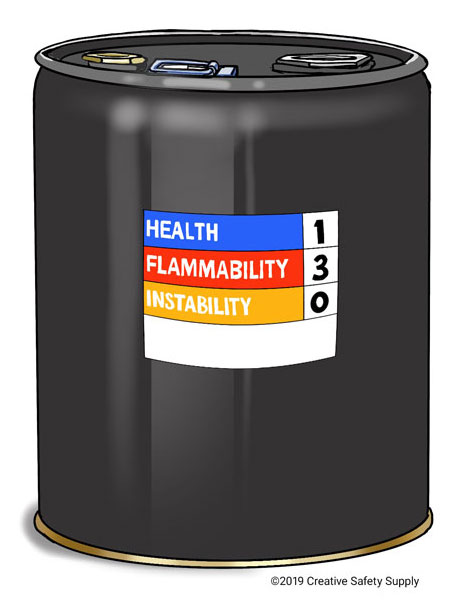
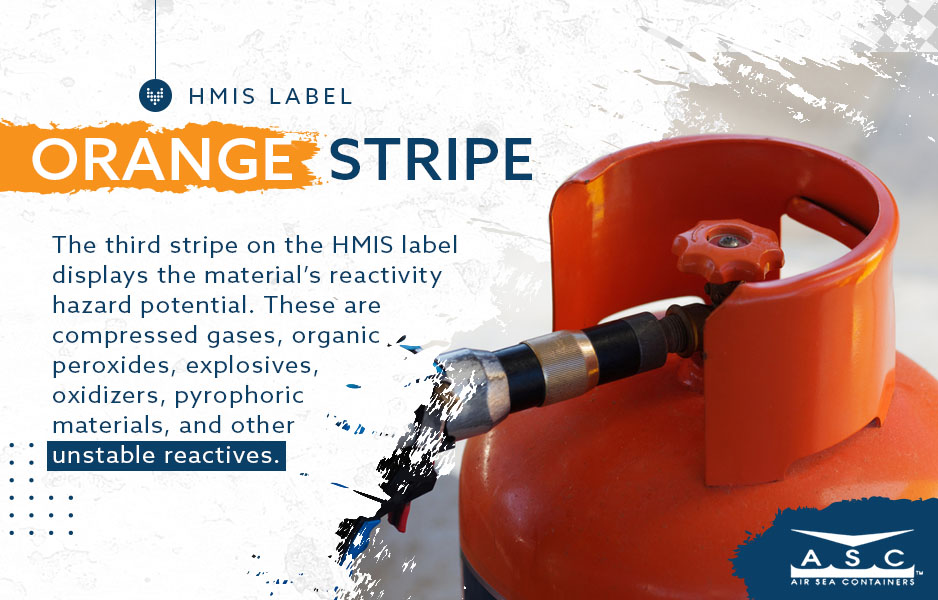

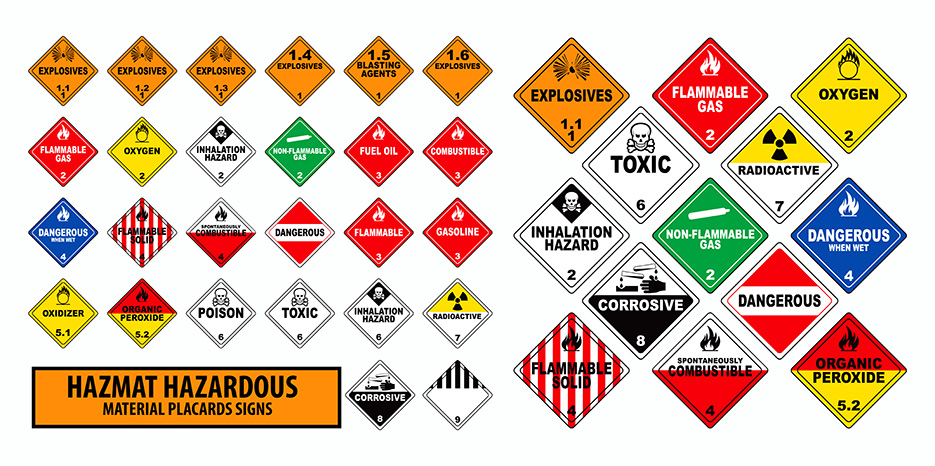

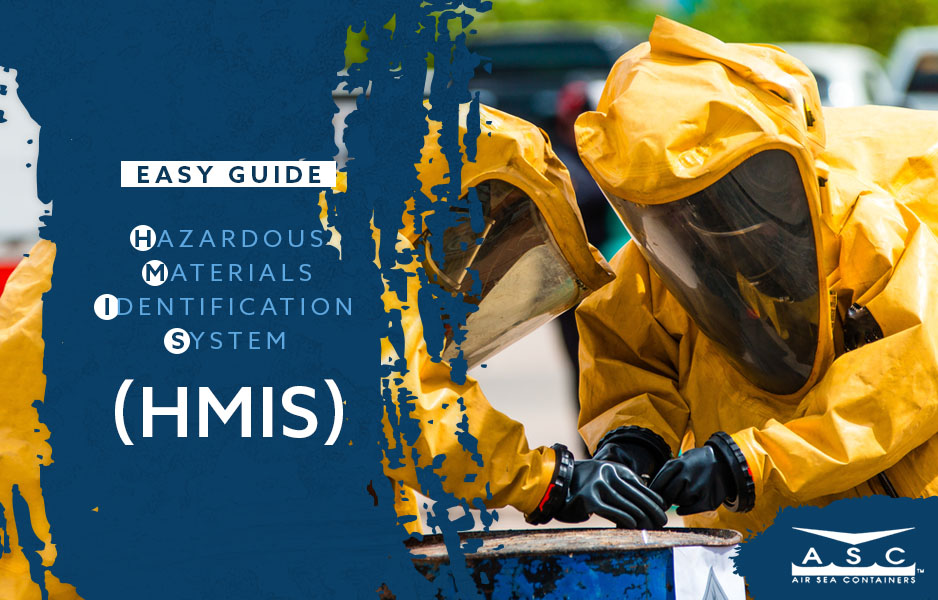


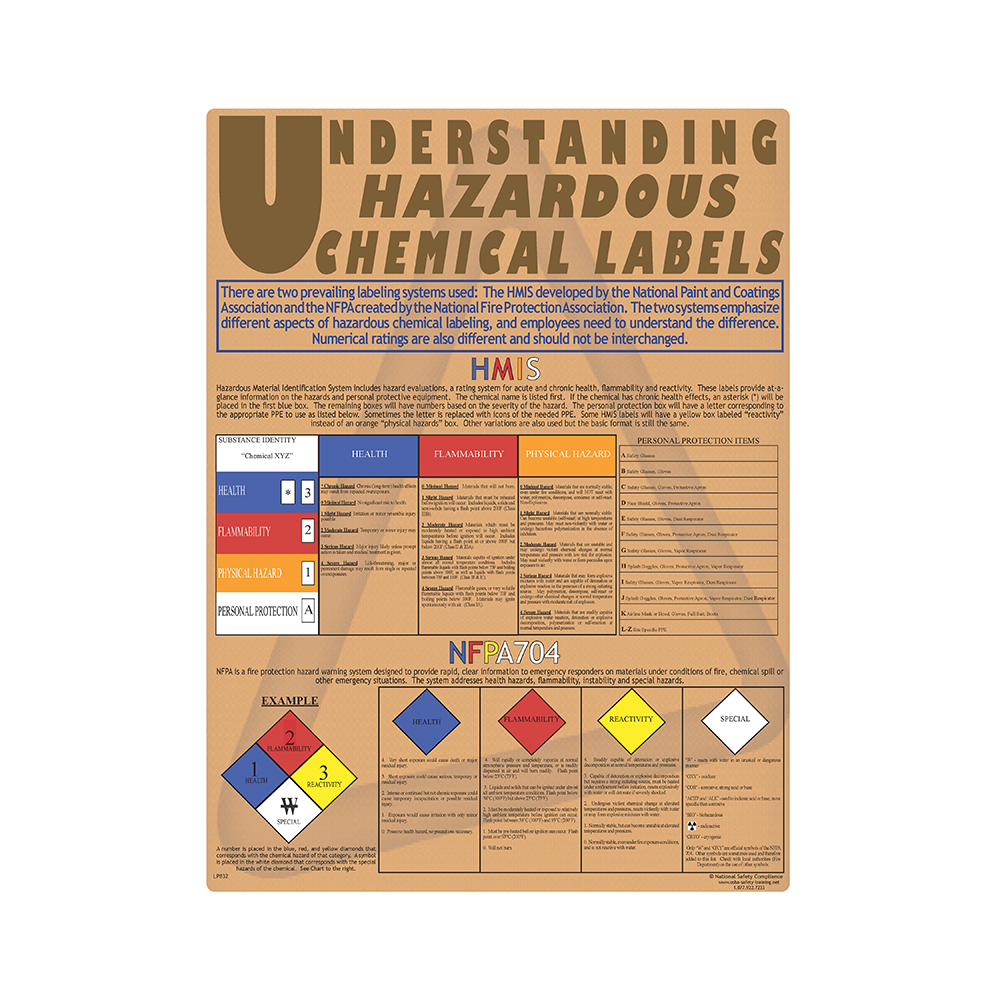

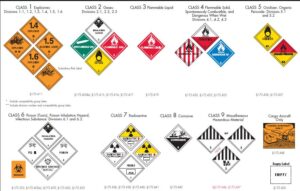

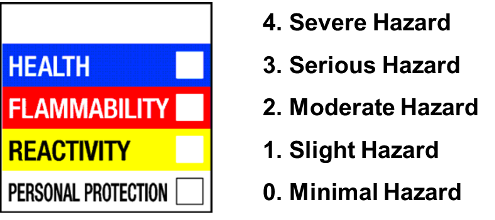
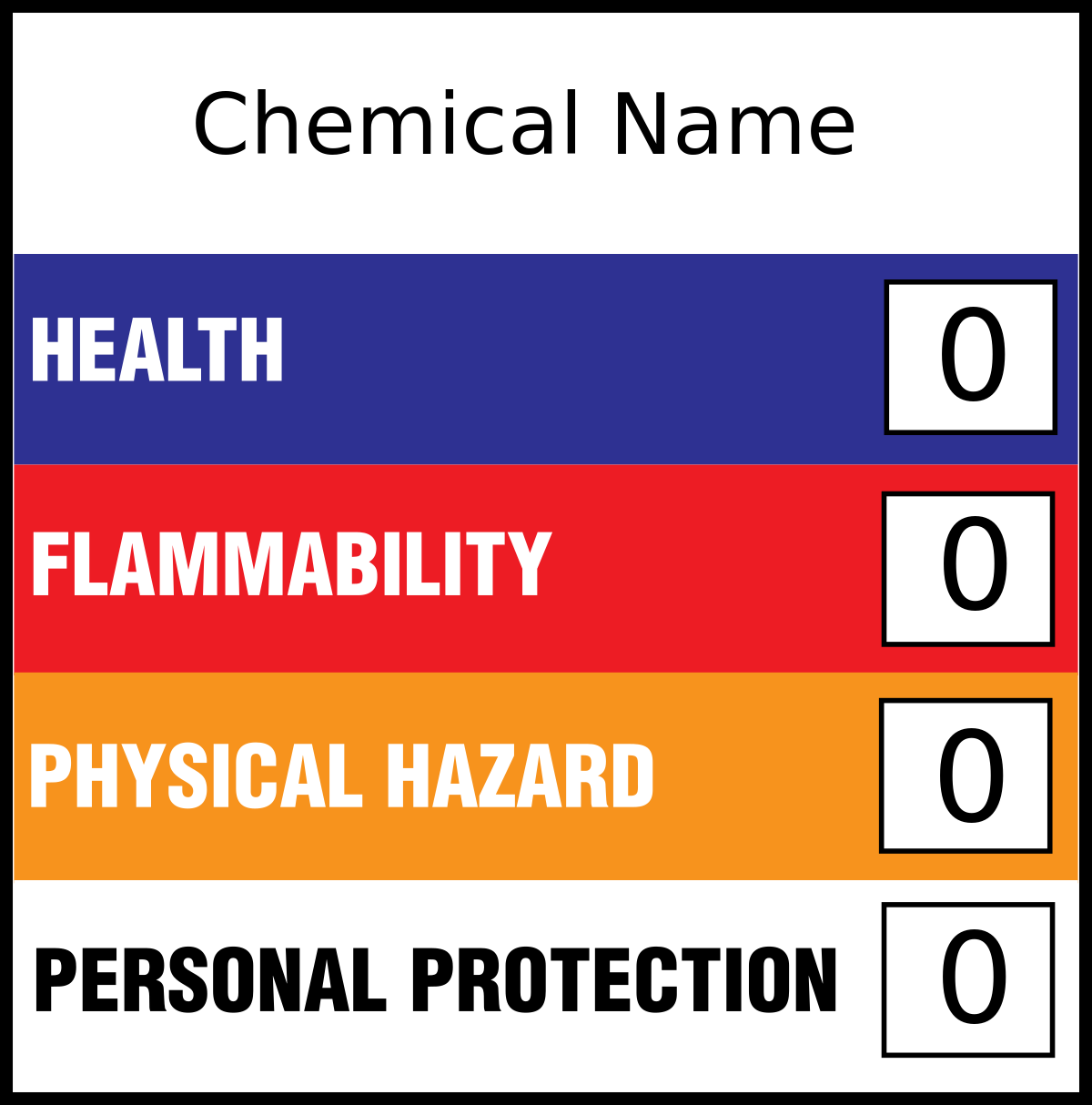




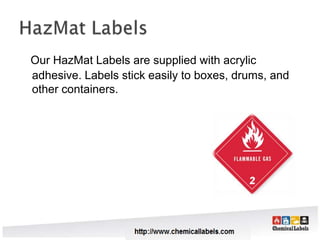




Post a Comment for "42 the red box on hmis labels indicate"